Operations Management: Strategic Process Analysis of Progressive
VerifiedAdded on 2023/04/21
|9
|2258
|178
Report
AI Summary
This report evaluates Progressive Insurance's operational management processes, emphasizing the importance of continuous improvement for enhanced customer satisfaction. It explores the implementation of a next-generation operating model, focusing on digital integration, advanced analytics, and intelligent process automation. The analysis highlights Progressive's success through operational innovation and dependability, particularly in leveraging technology for improved service delivery and cost efficiency. The report also identifies potential gaps in organizational processes and recommends hiring technological consultants and providing staff training to optimize performance and maintain a competitive edge. Ultimately, the goal is to streamline processes, minimize waste, and foster a customer-centric approach that strengthens dependability and drives sustainable growth.
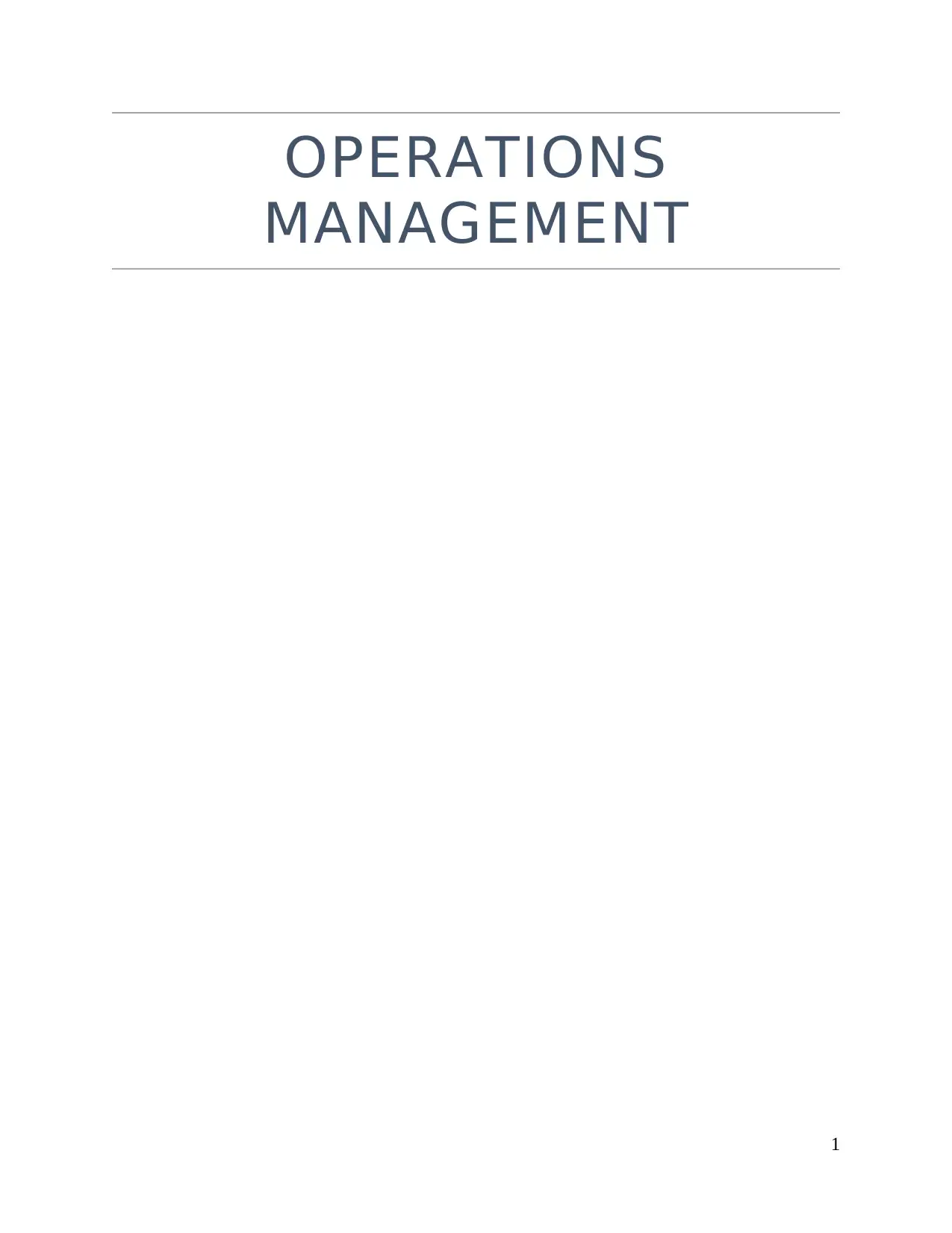
OPERATIONS
MANAGEMENT
1
MANAGEMENT
1
Paraphrase This Document
Need a fresh take? Get an instant paraphrase of this document with our AI Paraphraser
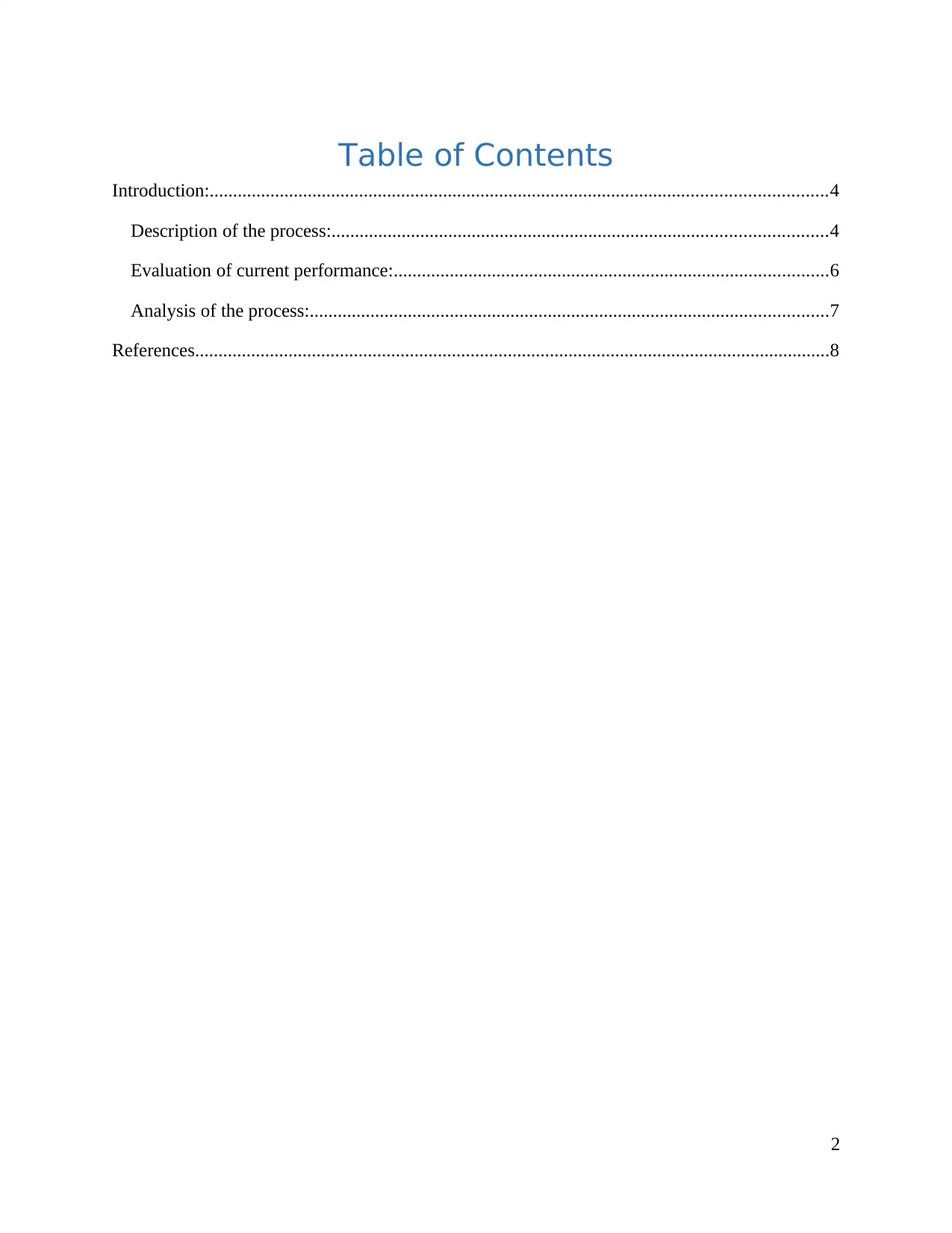
Table of Contents
Introduction:....................................................................................................................................4
Description of the process:..........................................................................................................4
Evaluation of current performance:.............................................................................................6
Analysis of the process:...............................................................................................................7
References........................................................................................................................................8
2
Introduction:....................................................................................................................................4
Description of the process:..........................................................................................................4
Evaluation of current performance:.............................................................................................6
Analysis of the process:...............................................................................................................7
References........................................................................................................................................8
2
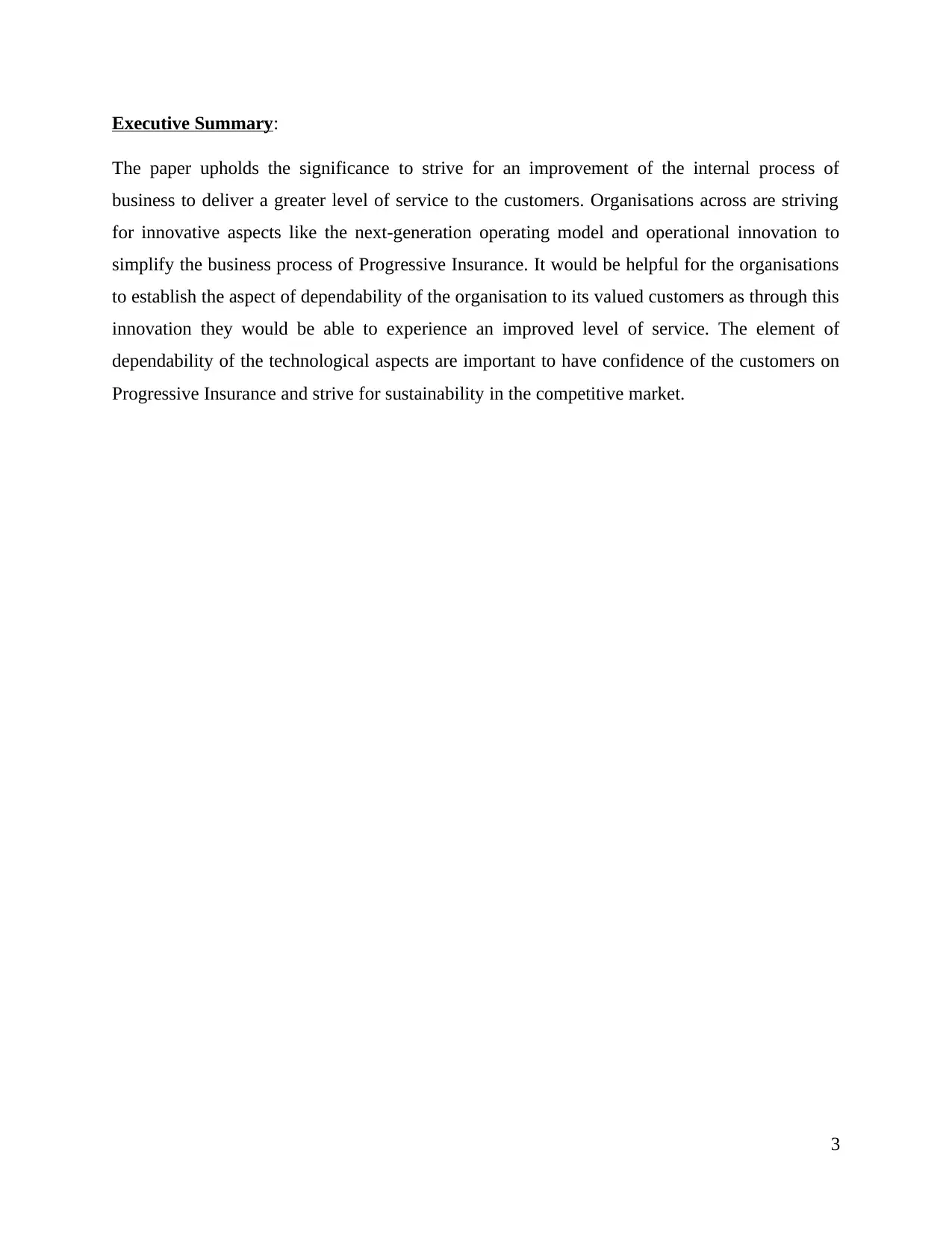
Executive Summary:
The paper upholds the significance to strive for an improvement of the internal process of
business to deliver a greater level of service to the customers. Organisations across are striving
for innovative aspects like the next-generation operating model and operational innovation to
simplify the business process of Progressive Insurance. It would be helpful for the organisations
to establish the aspect of dependability of the organisation to its valued customers as through this
innovation they would be able to experience an improved level of service. The element of
dependability of the technological aspects are important to have confidence of the customers on
Progressive Insurance and strive for sustainability in the competitive market.
3
The paper upholds the significance to strive for an improvement of the internal process of
business to deliver a greater level of service to the customers. Organisations across are striving
for innovative aspects like the next-generation operating model and operational innovation to
simplify the business process of Progressive Insurance. It would be helpful for the organisations
to establish the aspect of dependability of the organisation to its valued customers as through this
innovation they would be able to experience an improved level of service. The element of
dependability of the technological aspects are important to have confidence of the customers on
Progressive Insurance and strive for sustainability in the competitive market.
3
⊘ This is a preview!⊘
Do you want full access?
Subscribe today to unlock all pages.

Trusted by 1+ million students worldwide
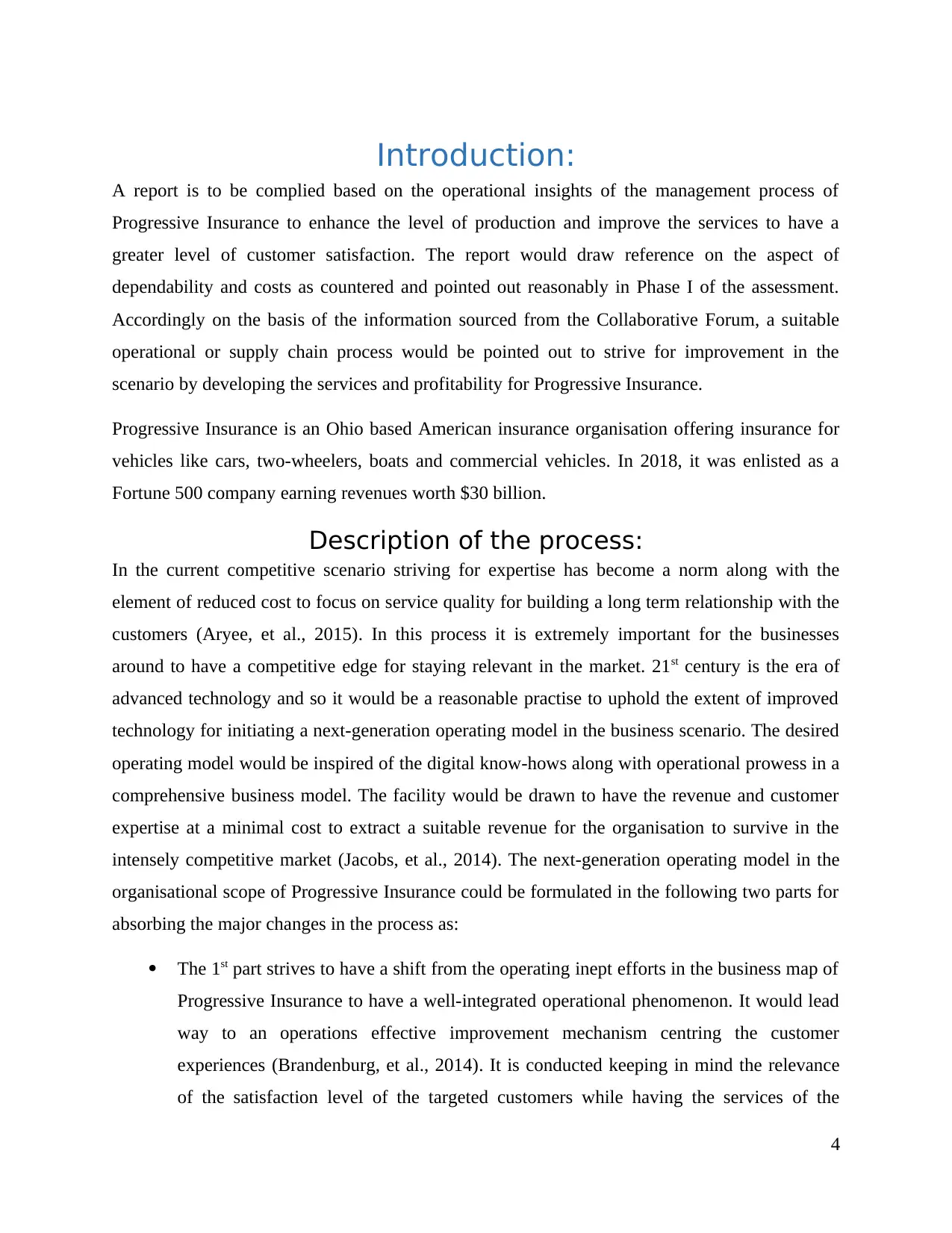
Introduction:
A report is to be complied based on the operational insights of the management process of
Progressive Insurance to enhance the level of production and improve the services to have a
greater level of customer satisfaction. The report would draw reference on the aspect of
dependability and costs as countered and pointed out reasonably in Phase I of the assessment.
Accordingly on the basis of the information sourced from the Collaborative Forum, a suitable
operational or supply chain process would be pointed out to strive for improvement in the
scenario by developing the services and profitability for Progressive Insurance.
Progressive Insurance is an Ohio based American insurance organisation offering insurance for
vehicles like cars, two-wheelers, boats and commercial vehicles. In 2018, it was enlisted as a
Fortune 500 company earning revenues worth $30 billion.
Description of the process:
In the current competitive scenario striving for expertise has become a norm along with the
element of reduced cost to focus on service quality for building a long term relationship with the
customers (Aryee, et al., 2015). In this process it is extremely important for the businesses
around to have a competitive edge for staying relevant in the market. 21st century is the era of
advanced technology and so it would be a reasonable practise to uphold the extent of improved
technology for initiating a next-generation operating model in the business scenario. The desired
operating model would be inspired of the digital know-hows along with operational prowess in a
comprehensive business model. The facility would be drawn to have the revenue and customer
expertise at a minimal cost to extract a suitable revenue for the organisation to survive in the
intensely competitive market (Jacobs, et al., 2014). The next-generation operating model in the
organisational scope of Progressive Insurance could be formulated in the following two parts for
absorbing the major changes in the process as:
The 1st part strives to have a shift from the operating inept efforts in the business map of
Progressive Insurance to have a well-integrated operational phenomenon. It would lead
way to an operations effective improvement mechanism centring the customer
experiences (Brandenburg, et al., 2014). It is conducted keeping in mind the relevance
of the satisfaction level of the targeted customers while having the services of the
4
A report is to be complied based on the operational insights of the management process of
Progressive Insurance to enhance the level of production and improve the services to have a
greater level of customer satisfaction. The report would draw reference on the aspect of
dependability and costs as countered and pointed out reasonably in Phase I of the assessment.
Accordingly on the basis of the information sourced from the Collaborative Forum, a suitable
operational or supply chain process would be pointed out to strive for improvement in the
scenario by developing the services and profitability for Progressive Insurance.
Progressive Insurance is an Ohio based American insurance organisation offering insurance for
vehicles like cars, two-wheelers, boats and commercial vehicles. In 2018, it was enlisted as a
Fortune 500 company earning revenues worth $30 billion.
Description of the process:
In the current competitive scenario striving for expertise has become a norm along with the
element of reduced cost to focus on service quality for building a long term relationship with the
customers (Aryee, et al., 2015). In this process it is extremely important for the businesses
around to have a competitive edge for staying relevant in the market. 21st century is the era of
advanced technology and so it would be a reasonable practise to uphold the extent of improved
technology for initiating a next-generation operating model in the business scenario. The desired
operating model would be inspired of the digital know-hows along with operational prowess in a
comprehensive business model. The facility would be drawn to have the revenue and customer
expertise at a minimal cost to extract a suitable revenue for the organisation to survive in the
intensely competitive market (Jacobs, et al., 2014). The next-generation operating model in the
organisational scope of Progressive Insurance could be formulated in the following two parts for
absorbing the major changes in the process as:
The 1st part strives to have a shift from the operating inept efforts in the business map of
Progressive Insurance to have a well-integrated operational phenomenon. It would lead
way to an operations effective improvement mechanism centring the customer
experiences (Brandenburg, et al., 2014). It is conducted keeping in mind the relevance
of the satisfaction level of the targeted customers while having the services of the
4
Paraphrase This Document
Need a fresh take? Get an instant paraphrase of this document with our AI Paraphraser
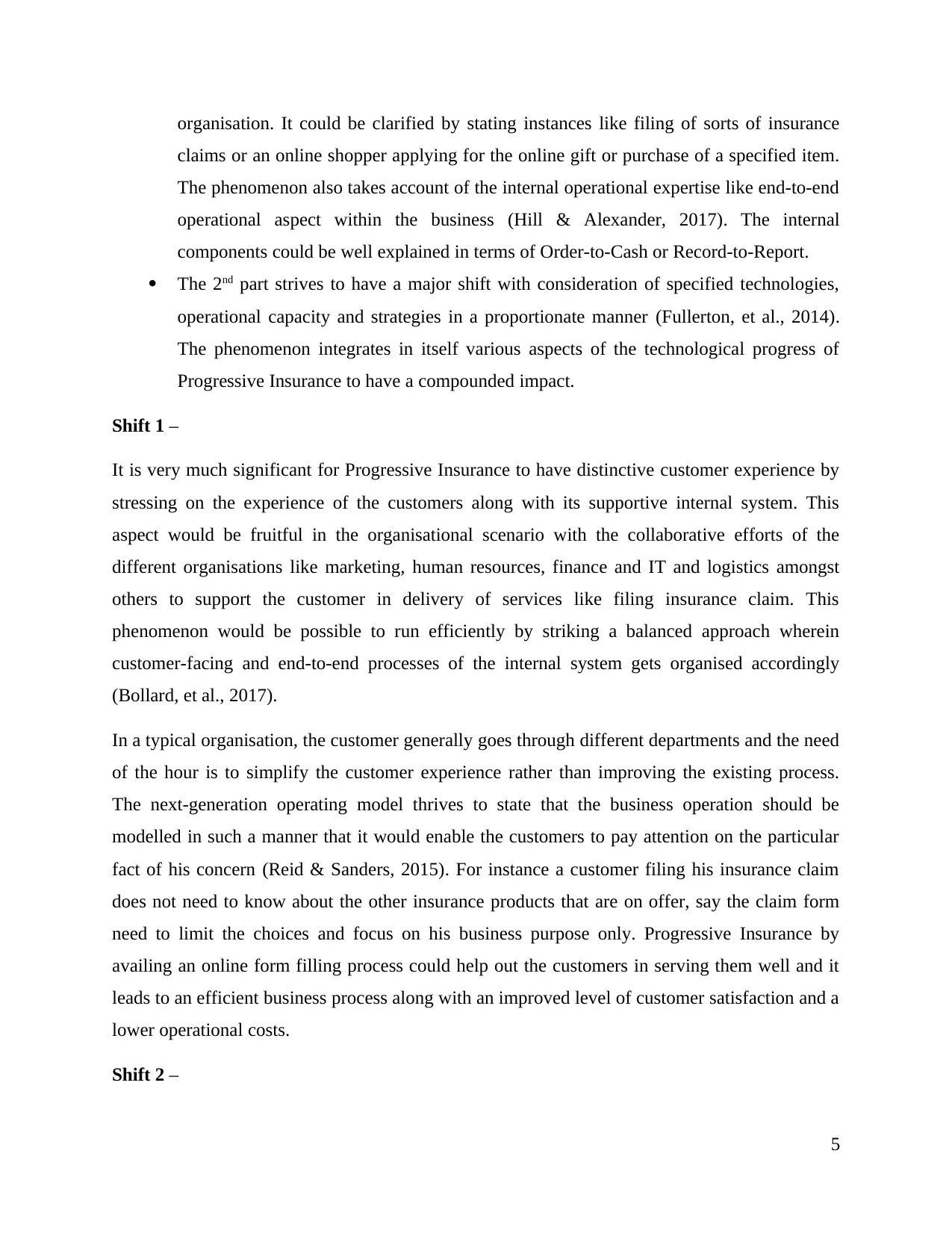
organisation. It could be clarified by stating instances like filing of sorts of insurance
claims or an online shopper applying for the online gift or purchase of a specified item.
The phenomenon also takes account of the internal operational expertise like end-to-end
operational aspect within the business (Hill & Alexander, 2017). The internal
components could be well explained in terms of Order-to-Cash or Record-to-Report.
The 2nd part strives to have a major shift with consideration of specified technologies,
operational capacity and strategies in a proportionate manner (Fullerton, et al., 2014).
The phenomenon integrates in itself various aspects of the technological progress of
Progressive Insurance to have a compounded impact.
Shift 1 –
It is very much significant for Progressive Insurance to have distinctive customer experience by
stressing on the experience of the customers along with its supportive internal system. This
aspect would be fruitful in the organisational scenario with the collaborative efforts of the
different organisations like marketing, human resources, finance and IT and logistics amongst
others to support the customer in delivery of services like filing insurance claim. This
phenomenon would be possible to run efficiently by striking a balanced approach wherein
customer-facing and end-to-end processes of the internal system gets organised accordingly
(Bollard, et al., 2017).
In a typical organisation, the customer generally goes through different departments and the need
of the hour is to simplify the customer experience rather than improving the existing process.
The next-generation operating model thrives to state that the business operation should be
modelled in such a manner that it would enable the customers to pay attention on the particular
fact of his concern (Reid & Sanders, 2015). For instance a customer filing his insurance claim
does not need to know about the other insurance products that are on offer, say the claim form
need to limit the choices and focus on his business purpose only. Progressive Insurance by
availing an online form filling process could help out the customers in serving them well and it
leads to an efficient business process along with an improved level of customer satisfaction and a
lower operational costs.
Shift 2 –
5
claims or an online shopper applying for the online gift or purchase of a specified item.
The phenomenon also takes account of the internal operational expertise like end-to-end
operational aspect within the business (Hill & Alexander, 2017). The internal
components could be well explained in terms of Order-to-Cash or Record-to-Report.
The 2nd part strives to have a major shift with consideration of specified technologies,
operational capacity and strategies in a proportionate manner (Fullerton, et al., 2014).
The phenomenon integrates in itself various aspects of the technological progress of
Progressive Insurance to have a compounded impact.
Shift 1 –
It is very much significant for Progressive Insurance to have distinctive customer experience by
stressing on the experience of the customers along with its supportive internal system. This
aspect would be fruitful in the organisational scenario with the collaborative efforts of the
different organisations like marketing, human resources, finance and IT and logistics amongst
others to support the customer in delivery of services like filing insurance claim. This
phenomenon would be possible to run efficiently by striking a balanced approach wherein
customer-facing and end-to-end processes of the internal system gets organised accordingly
(Bollard, et al., 2017).
In a typical organisation, the customer generally goes through different departments and the need
of the hour is to simplify the customer experience rather than improving the existing process.
The next-generation operating model thrives to state that the business operation should be
modelled in such a manner that it would enable the customers to pay attention on the particular
fact of his concern (Reid & Sanders, 2015). For instance a customer filing his insurance claim
does not need to know about the other insurance products that are on offer, say the claim form
need to limit the choices and focus on his business purpose only. Progressive Insurance by
availing an online form filling process could help out the customers in serving them well and it
leads to an efficient business process along with an improved level of customer satisfaction and a
lower operational costs.
Shift 2 –
5
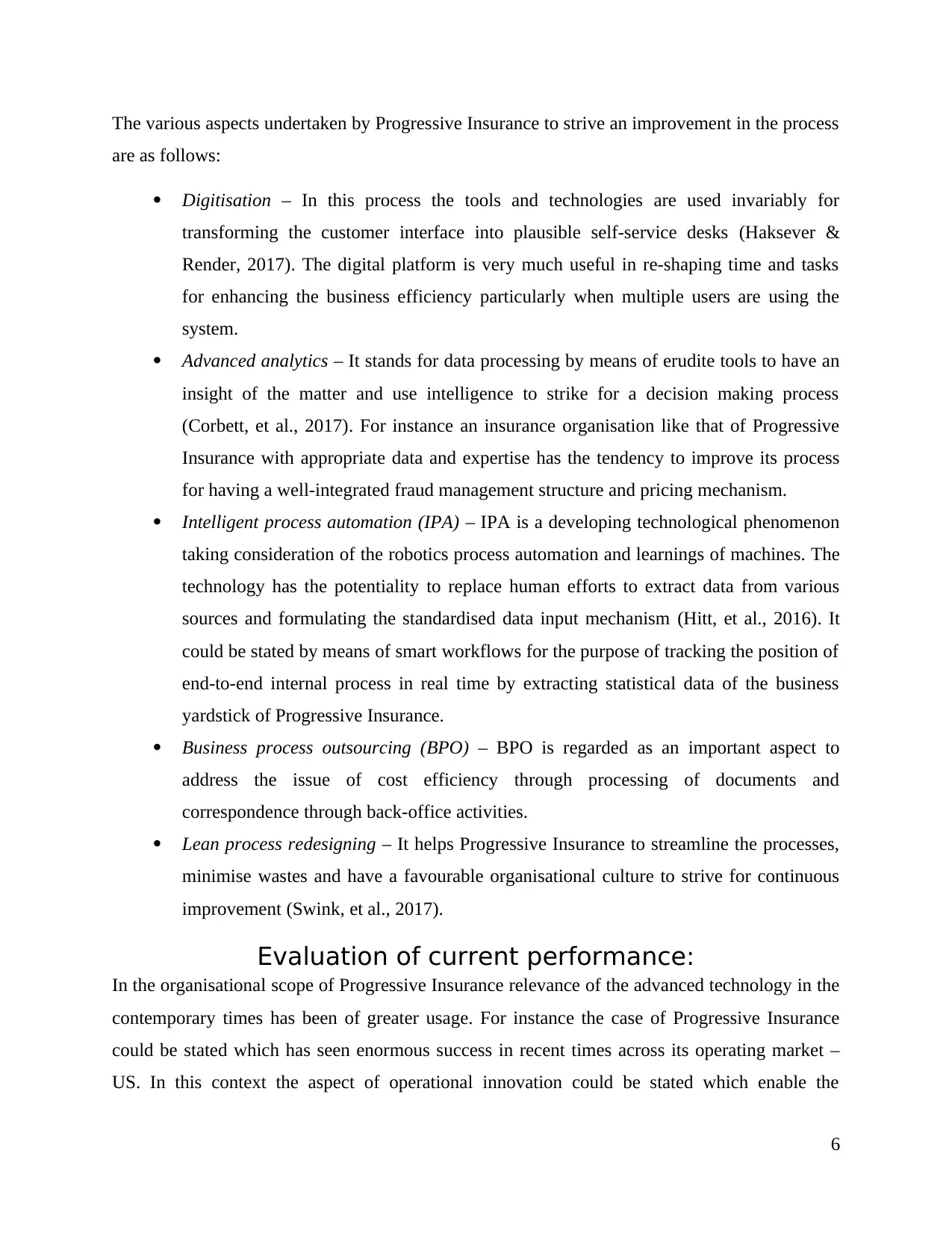
The various aspects undertaken by Progressive Insurance to strive an improvement in the process
are as follows:
Digitisation – In this process the tools and technologies are used invariably for
transforming the customer interface into plausible self-service desks (Haksever &
Render, 2017). The digital platform is very much useful in re-shaping time and tasks
for enhancing the business efficiency particularly when multiple users are using the
system.
Advanced analytics – It stands for data processing by means of erudite tools to have an
insight of the matter and use intelligence to strike for a decision making process
(Corbett, et al., 2017). For instance an insurance organisation like that of Progressive
Insurance with appropriate data and expertise has the tendency to improve its process
for having a well-integrated fraud management structure and pricing mechanism.
Intelligent process automation (IPA) – IPA is a developing technological phenomenon
taking consideration of the robotics process automation and learnings of machines. The
technology has the potentiality to replace human efforts to extract data from various
sources and formulating the standardised data input mechanism (Hitt, et al., 2016). It
could be stated by means of smart workflows for the purpose of tracking the position of
end-to-end internal process in real time by extracting statistical data of the business
yardstick of Progressive Insurance.
Business process outsourcing (BPO) – BPO is regarded as an important aspect to
address the issue of cost efficiency through processing of documents and
correspondence through back-office activities.
Lean process redesigning – It helps Progressive Insurance to streamline the processes,
minimise wastes and have a favourable organisational culture to strive for continuous
improvement (Swink, et al., 2017).
Evaluation of current performance:
In the organisational scope of Progressive Insurance relevance of the advanced technology in the
contemporary times has been of greater usage. For instance the case of Progressive Insurance
could be stated which has seen enormous success in recent times across its operating market –
US. In this context the aspect of operational innovation could be stated which enable the
6
are as follows:
Digitisation – In this process the tools and technologies are used invariably for
transforming the customer interface into plausible self-service desks (Haksever &
Render, 2017). The digital platform is very much useful in re-shaping time and tasks
for enhancing the business efficiency particularly when multiple users are using the
system.
Advanced analytics – It stands for data processing by means of erudite tools to have an
insight of the matter and use intelligence to strike for a decision making process
(Corbett, et al., 2017). For instance an insurance organisation like that of Progressive
Insurance with appropriate data and expertise has the tendency to improve its process
for having a well-integrated fraud management structure and pricing mechanism.
Intelligent process automation (IPA) – IPA is a developing technological phenomenon
taking consideration of the robotics process automation and learnings of machines. The
technology has the potentiality to replace human efforts to extract data from various
sources and formulating the standardised data input mechanism (Hitt, et al., 2016). It
could be stated by means of smart workflows for the purpose of tracking the position of
end-to-end internal process in real time by extracting statistical data of the business
yardstick of Progressive Insurance.
Business process outsourcing (BPO) – BPO is regarded as an important aspect to
address the issue of cost efficiency through processing of documents and
correspondence through back-office activities.
Lean process redesigning – It helps Progressive Insurance to streamline the processes,
minimise wastes and have a favourable organisational culture to strive for continuous
improvement (Swink, et al., 2017).
Evaluation of current performance:
In the organisational scope of Progressive Insurance relevance of the advanced technology in the
contemporary times has been of greater usage. For instance the case of Progressive Insurance
could be stated which has seen enormous success in recent times across its operating market –
US. In this context the aspect of operational innovation could be stated which enable the
6
⊘ This is a preview!⊘
Do you want full access?
Subscribe today to unlock all pages.

Trusted by 1+ million students worldwide
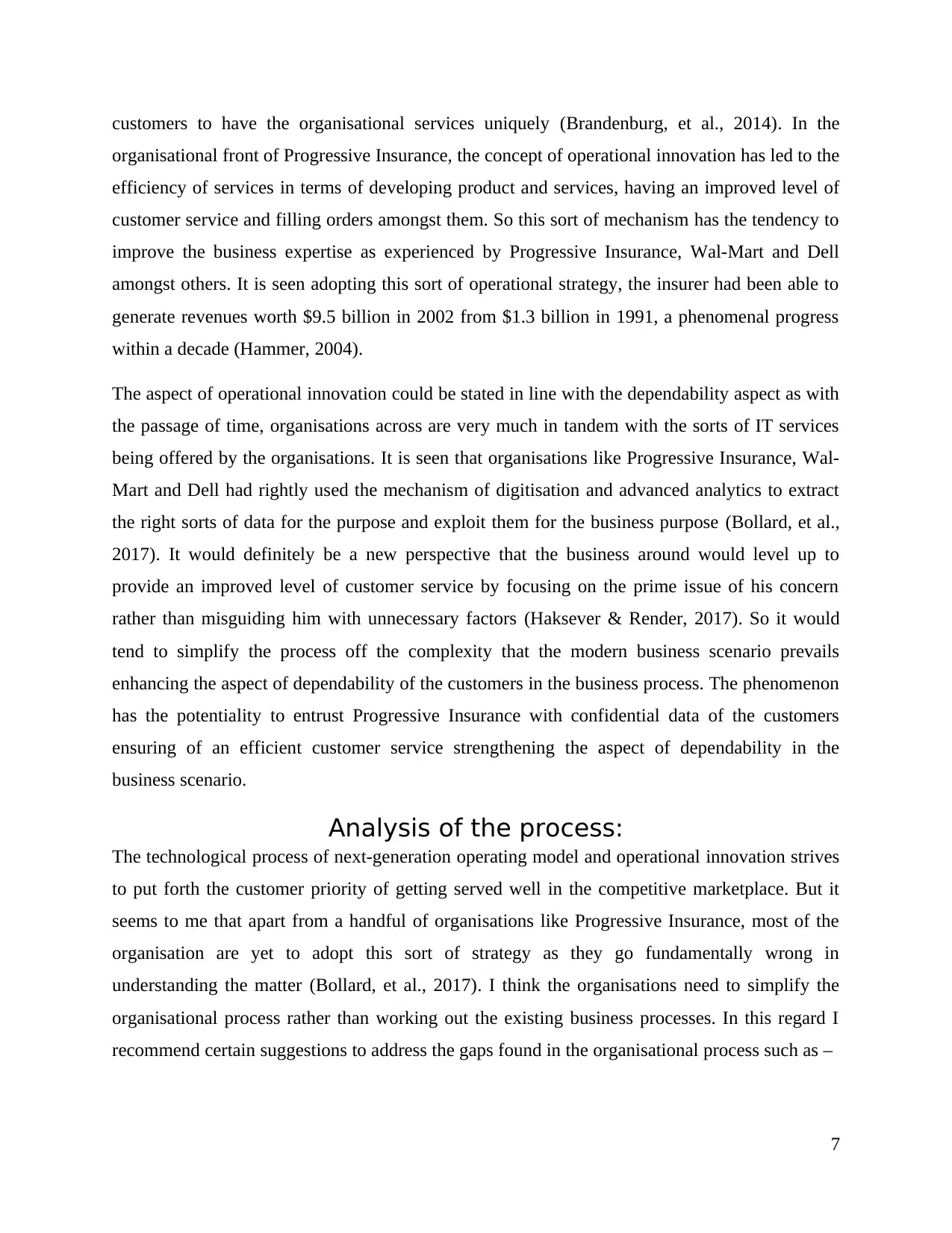
customers to have the organisational services uniquely (Brandenburg, et al., 2014). In the
organisational front of Progressive Insurance, the concept of operational innovation has led to the
efficiency of services in terms of developing product and services, having an improved level of
customer service and filling orders amongst them. So this sort of mechanism has the tendency to
improve the business expertise as experienced by Progressive Insurance, Wal-Mart and Dell
amongst others. It is seen adopting this sort of operational strategy, the insurer had been able to
generate revenues worth $9.5 billion in 2002 from $1.3 billion in 1991, a phenomenal progress
within a decade (Hammer, 2004).
The aspect of operational innovation could be stated in line with the dependability aspect as with
the passage of time, organisations across are very much in tandem with the sorts of IT services
being offered by the organisations. It is seen that organisations like Progressive Insurance, Wal-
Mart and Dell had rightly used the mechanism of digitisation and advanced analytics to extract
the right sorts of data for the purpose and exploit them for the business purpose (Bollard, et al.,
2017). It would definitely be a new perspective that the business around would level up to
provide an improved level of customer service by focusing on the prime issue of his concern
rather than misguiding him with unnecessary factors (Haksever & Render, 2017). So it would
tend to simplify the process off the complexity that the modern business scenario prevails
enhancing the aspect of dependability of the customers in the business process. The phenomenon
has the potentiality to entrust Progressive Insurance with confidential data of the customers
ensuring of an efficient customer service strengthening the aspect of dependability in the
business scenario.
Analysis of the process:
The technological process of next-generation operating model and operational innovation strives
to put forth the customer priority of getting served well in the competitive marketplace. But it
seems to me that apart from a handful of organisations like Progressive Insurance, most of the
organisation are yet to adopt this sort of strategy as they go fundamentally wrong in
understanding the matter (Bollard, et al., 2017). I think the organisations need to simplify the
organisational process rather than working out the existing business processes. In this regard I
recommend certain suggestions to address the gaps found in the organisational process such as –
7
organisational front of Progressive Insurance, the concept of operational innovation has led to the
efficiency of services in terms of developing product and services, having an improved level of
customer service and filling orders amongst them. So this sort of mechanism has the tendency to
improve the business expertise as experienced by Progressive Insurance, Wal-Mart and Dell
amongst others. It is seen adopting this sort of operational strategy, the insurer had been able to
generate revenues worth $9.5 billion in 2002 from $1.3 billion in 1991, a phenomenal progress
within a decade (Hammer, 2004).
The aspect of operational innovation could be stated in line with the dependability aspect as with
the passage of time, organisations across are very much in tandem with the sorts of IT services
being offered by the organisations. It is seen that organisations like Progressive Insurance, Wal-
Mart and Dell had rightly used the mechanism of digitisation and advanced analytics to extract
the right sorts of data for the purpose and exploit them for the business purpose (Bollard, et al.,
2017). It would definitely be a new perspective that the business around would level up to
provide an improved level of customer service by focusing on the prime issue of his concern
rather than misguiding him with unnecessary factors (Haksever & Render, 2017). So it would
tend to simplify the process off the complexity that the modern business scenario prevails
enhancing the aspect of dependability of the customers in the business process. The phenomenon
has the potentiality to entrust Progressive Insurance with confidential data of the customers
ensuring of an efficient customer service strengthening the aspect of dependability in the
business scenario.
Analysis of the process:
The technological process of next-generation operating model and operational innovation strives
to put forth the customer priority of getting served well in the competitive marketplace. But it
seems to me that apart from a handful of organisations like Progressive Insurance, most of the
organisation are yet to adopt this sort of strategy as they go fundamentally wrong in
understanding the matter (Bollard, et al., 2017). I think the organisations need to simplify the
organisational process rather than working out the existing business processes. In this regard I
recommend certain suggestions to address the gaps found in the organisational process such as –
7
Paraphrase This Document
Need a fresh take? Get an instant paraphrase of this document with our AI Paraphraser
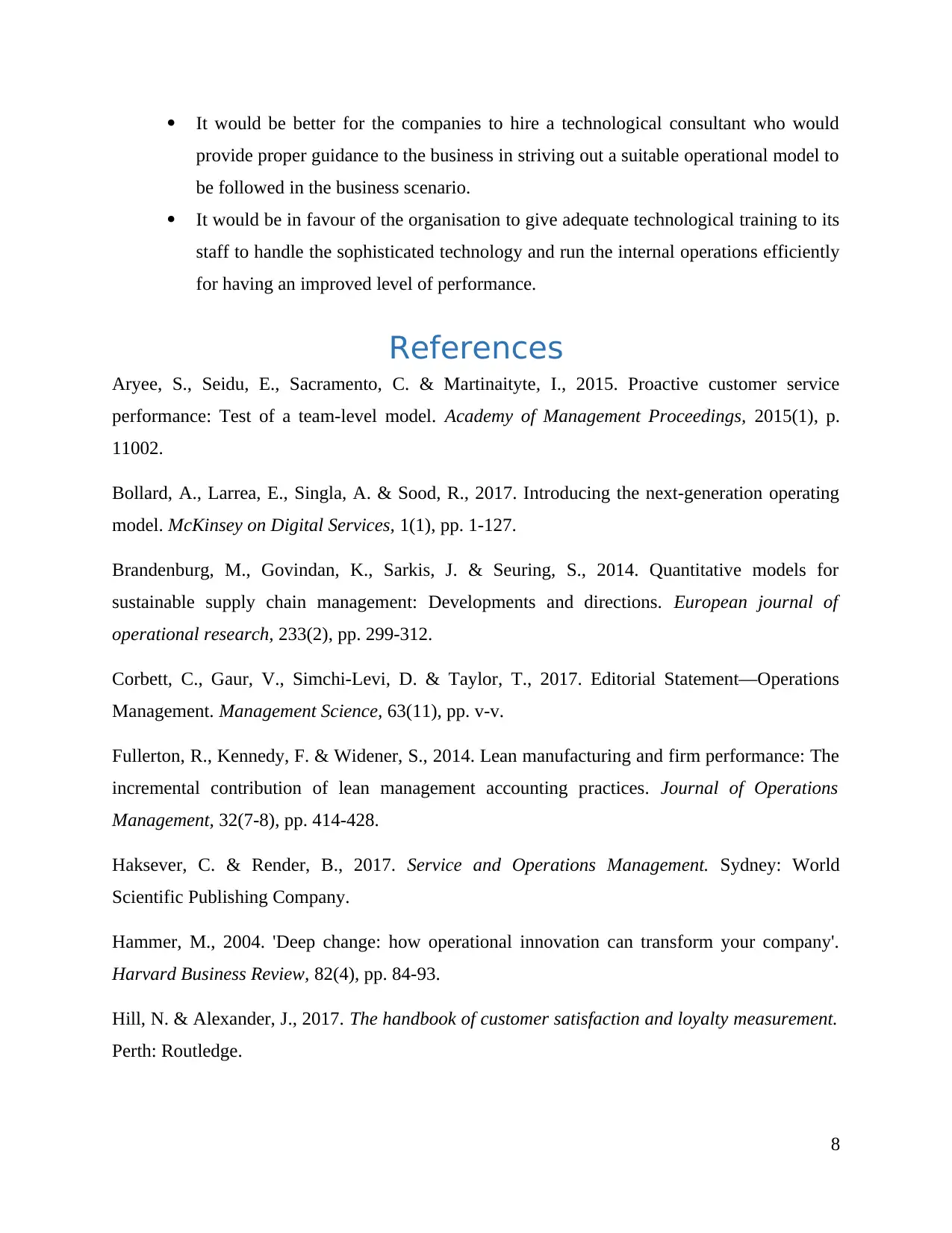
It would be better for the companies to hire a technological consultant who would
provide proper guidance to the business in striving out a suitable operational model to
be followed in the business scenario.
It would be in favour of the organisation to give adequate technological training to its
staff to handle the sophisticated technology and run the internal operations efficiently
for having an improved level of performance.
References
Aryee, S., Seidu, E., Sacramento, C. & Martinaityte, I., 2015. Proactive customer service
performance: Test of a team-level model. Academy of Management Proceedings, 2015(1), p.
11002.
Bollard, A., Larrea, E., Singla, A. & Sood, R., 2017. Introducing the next-generation operating
model. McKinsey on Digital Services, 1(1), pp. 1-127.
Brandenburg, M., Govindan, K., Sarkis, J. & Seuring, S., 2014. Quantitative models for
sustainable supply chain management: Developments and directions. European journal of
operational research, 233(2), pp. 299-312.
Corbett, C., Gaur, V., Simchi-Levi, D. & Taylor, T., 2017. Editorial Statement—Operations
Management. Management Science, 63(11), pp. v-v.
Fullerton, R., Kennedy, F. & Widener, S., 2014. Lean manufacturing and firm performance: The
incremental contribution of lean management accounting practices. Journal of Operations
Management, 32(7-8), pp. 414-428.
Haksever, C. & Render, B., 2017. Service and Operations Management. Sydney: World
Scientific Publishing Company.
Hammer, M., 2004. 'Deep change: how operational innovation can transform your company'.
Harvard Business Review, 82(4), pp. 84-93.
Hill, N. & Alexander, J., 2017. The handbook of customer satisfaction and loyalty measurement.
Perth: Routledge.
8
provide proper guidance to the business in striving out a suitable operational model to
be followed in the business scenario.
It would be in favour of the organisation to give adequate technological training to its
staff to handle the sophisticated technology and run the internal operations efficiently
for having an improved level of performance.
References
Aryee, S., Seidu, E., Sacramento, C. & Martinaityte, I., 2015. Proactive customer service
performance: Test of a team-level model. Academy of Management Proceedings, 2015(1), p.
11002.
Bollard, A., Larrea, E., Singla, A. & Sood, R., 2017. Introducing the next-generation operating
model. McKinsey on Digital Services, 1(1), pp. 1-127.
Brandenburg, M., Govindan, K., Sarkis, J. & Seuring, S., 2014. Quantitative models for
sustainable supply chain management: Developments and directions. European journal of
operational research, 233(2), pp. 299-312.
Corbett, C., Gaur, V., Simchi-Levi, D. & Taylor, T., 2017. Editorial Statement—Operations
Management. Management Science, 63(11), pp. v-v.
Fullerton, R., Kennedy, F. & Widener, S., 2014. Lean manufacturing and firm performance: The
incremental contribution of lean management accounting practices. Journal of Operations
Management, 32(7-8), pp. 414-428.
Haksever, C. & Render, B., 2017. Service and Operations Management. Sydney: World
Scientific Publishing Company.
Hammer, M., 2004. 'Deep change: how operational innovation can transform your company'.
Harvard Business Review, 82(4), pp. 84-93.
Hill, N. & Alexander, J., 2017. The handbook of customer satisfaction and loyalty measurement.
Perth: Routledge.
8
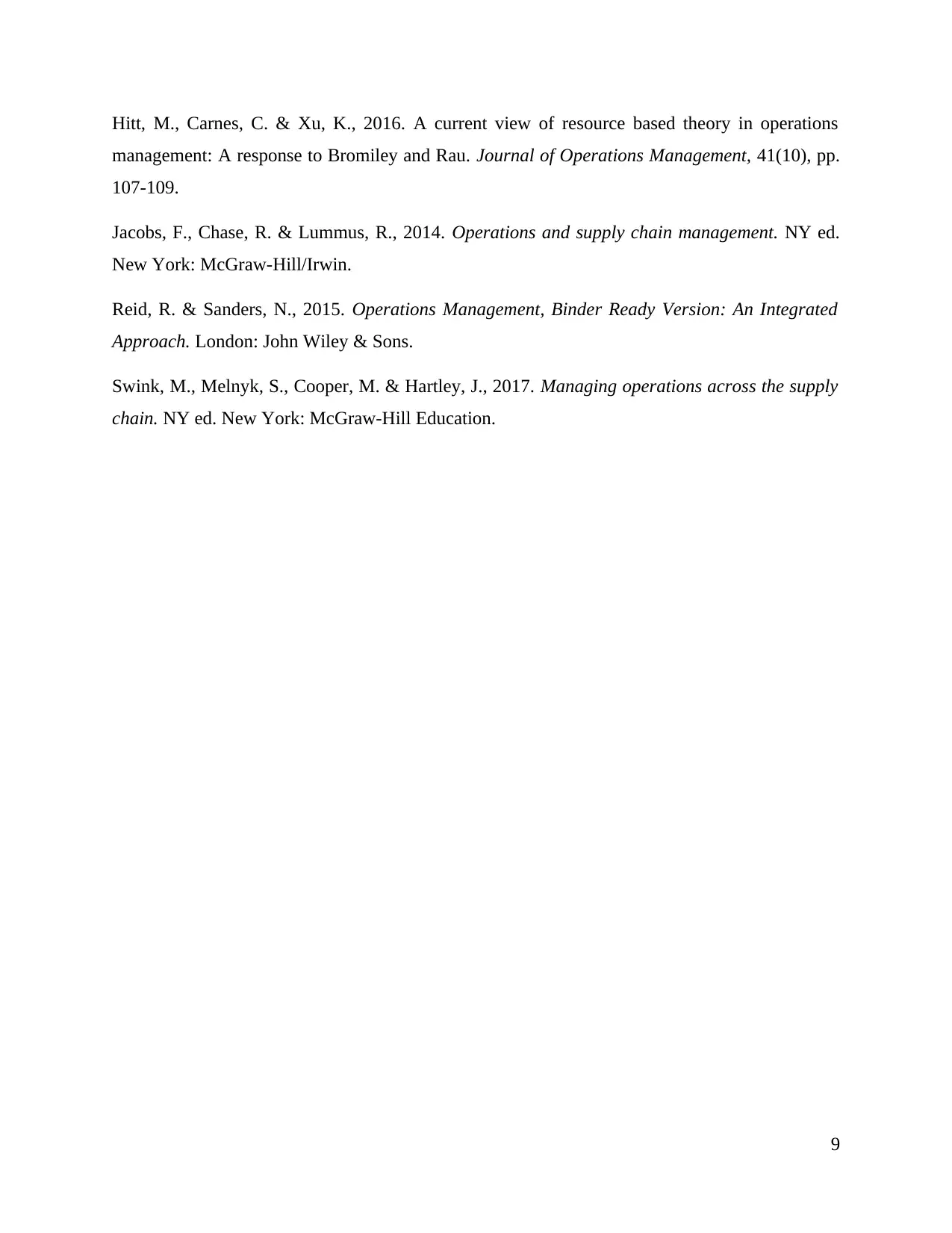
Hitt, M., Carnes, C. & Xu, K., 2016. A current view of resource based theory in operations
management: A response to Bromiley and Rau. Journal of Operations Management, 41(10), pp.
107-109.
Jacobs, F., Chase, R. & Lummus, R., 2014. Operations and supply chain management. NY ed.
New York: McGraw-Hill/Irwin.
Reid, R. & Sanders, N., 2015. Operations Management, Binder Ready Version: An Integrated
Approach. London: John Wiley & Sons.
Swink, M., Melnyk, S., Cooper, M. & Hartley, J., 2017. Managing operations across the supply
chain. NY ed. New York: McGraw-Hill Education.
9
management: A response to Bromiley and Rau. Journal of Operations Management, 41(10), pp.
107-109.
Jacobs, F., Chase, R. & Lummus, R., 2014. Operations and supply chain management. NY ed.
New York: McGraw-Hill/Irwin.
Reid, R. & Sanders, N., 2015. Operations Management, Binder Ready Version: An Integrated
Approach. London: John Wiley & Sons.
Swink, M., Melnyk, S., Cooper, M. & Hartley, J., 2017. Managing operations across the supply
chain. NY ed. New York: McGraw-Hill Education.
9
⊘ This is a preview!⊘
Do you want full access?
Subscribe today to unlock all pages.

Trusted by 1+ million students worldwide
1 out of 9
Related Documents
Your All-in-One AI-Powered Toolkit for Academic Success.
+13062052269
info@desklib.com
Available 24*7 on WhatsApp / Email
![[object Object]](/_next/static/media/star-bottom.7253800d.svg)
Unlock your academic potential
Copyright © 2020–2025 A2Z Services. All Rights Reserved. Developed and managed by ZUCOL.




